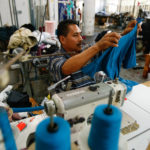Sweatshops Then vs. Now
I was amazed walking through the tenement house, seeing how small the apartments were and finding out how many people lived in each; it was surprising to me that an eight-person family would have had to make due living and sometimes working in a space that small. Learning about two particular immigrant families touched me since each had their own story and way of life that were both similar to and different from each other. Learning about the garment factories that families ran in their own homes as well as the larger sweatshop factories that were established was an additional eye-opening experience for me. I remember learning about the sweatshop factories in middle school and high school, but to be put in the immigrants’ shoes by touring a legitimate tenement house, seeing printed government census reports as well as images of these families, of Orchard Street, and of the sweatshop factories impacted me.
I learned at the museum that mostly women worked in the sweatshops and they were paid very low wages, following the gender roles of the time. The health conditions were fatal, especially because of all the fabric dust they would inhale from the air. Additionally, they worked very long hours, ranging from fifty to close to one hundred hours per week. The larger sweatshop factories resembled a high school cafeteria; they were very crowded spaces with little to no sanitation. Unfortunately, immigrants had to deal with these conditions because they had just moved to a new country where they were unfamiliar with the language and had no idea where to start; they were desperate to find a job to start rebuilding their lives and to support their families. However, many joined labor unions and went on strikes, but this did not bring positive results. I believe sweatshops can be a good thing for immigrants to an extent, that being that they were at least employed and were paid. It is difficult for foreigners who have no idea how society runs in a country other than their own to find a job, and other jobs that do not require one to speak a certain language or to have a specific skill set, such as various housekeeping jobs, would have had equally unfair working traditions. Employers took advantage of the immigrants’ desperation to find a job, and found no shame in treating them unjustly.


According to Benjamin Powell, the author of the article Meet the Old Sweatshops: Same as the New, the conditions in the sweatshops of the past were worse than those in many currently operating sweatshops. Child labor was very common back then and the cities were dangerously swelling with people and disease.[1] However, an article published by Los Angeles Times about the factory workers for Forever 21 proves the unfortunate fact that sweatshops still persist today in America and that many of the unsanitary conditions in the early sweatshops exist in those of today. The claims made in this article parallel those made on our tour in the city. It is distressing to think that many of the articles of clothing we wear, even those that are sold to us at a high price, are made by laborers who work about 10 hours a day and are paid a few dollars an hour. As said in the article, these factories are “stifling” and “sweltering” and consist of only “one-room workshops” where workers sit “behind a sewing machine,” similar to those of the past. Additionally, the factories in America such as the one located in Los Angeles where the workers produce the clothing for the brand Forever 21, aim to keep the prices low so they hire immigrants, many of them undocumented, who are willing to work for below minimum wage.[2]
After the field trip to the museum and reading these two articles, my eyes have been opened and I have become more sensitive and curious about the past in relation to the present as well as about the stories of different immigrants.
Bibliography
[1] Powell, Benjamin. “Meet the Old Sweatshops: Same as the New.” The Independent Review, v. 19, n. 1, Summer 2014, ISSN 1086–1653, 2014, pp. 109–122.https://www.independent.org/pdf/tir/tir_19_01_08_powell.pdf
[2] Kitroeff, Natalie, and Victoria Kim. “Behind a $13 Shirt, a $6-an-Hour Worker.” Los Angeles Times. Los Angeles Times, August 31, 2017. https://www.latimes.com/projects/la-fi-forever-21-factory-workers/.